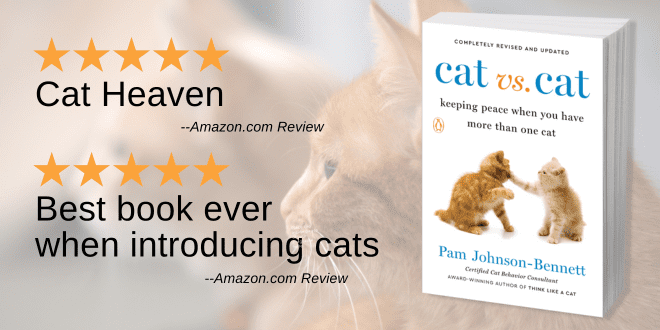
You just placed your cat’s food bowl on the floor and it seems as if in mere seconds, everything has been gobbled up. Eating too rapidly can have health implications as well as causing discomfort. In many cases, rapid eating results in the food making an immediate reappearance through regurgitation and causing your cat to feel just as hungry a few minutes later.
Why Do Some Cats Eat So Fast?
There can be numerous behavioral reasons why cats eat too quickly but it’s important to first rule out medical causes. Diabetes and hyperthyroidism, for example, can cause a cat to feel ravenously hungry and eat too quickly. Some cats gulp food when they’re experiencing mouth or tooth pain, because they want to limit dental pressure. Certain foods can also cause a cat to eat too quickly as well. There may be a particular flavor or type of food that the cat loves so much they can hardly wait to consume it. There are many medical causes of rapid eating and it’s critical to rule those possibilities out to prevent a cat from developing more serious complications as a result.
Behavior issues can be the reason many cats eat too rapidly. Boredom is a huge contributing factor when it comes to rapid eating, as well as over-eating. Loneliness is also a reason a cat may eat too fast. In multicat or multipet households, intimidation and competition can come into play. A cat may feel if he doesn’t eat his food fast, it will be stolen. Household chaos and noise close to the feeding station can create anxiety for a cat and he may eat as quickly as possible so he can escape from all the commotion.
Below are some tips to help you establish a healthier mealtime routine and encourage your cat to eat more slowly, but it’s very important that you identify the cause of the rapid eating.
1. Consult Your Veterinarian
Gulping the food may be due to an underlying health issue. Have your veterinarian evaluate your cat’s overall health because specific dietary recommendations may be needed. Even if you’re sure the problem is behavioral, it’s wise to first make certain health-related causes are not responsible. Your veterinarian can also advise you on how much you should feed per day based on your cat’s health, body type, age, and activity level.
2. Feed Smaller Meals More Frequently
Cats have small stomachs. Smaller, more frequent meals are easier on the digestive system and are a more natural way of eating for felines. If you feed on a schedule, you may be spacing the meals too far apart and the cat is getting too hungry. Frequent small meals per day aligns with how cats would naturally eat. Identify the overall daily portion your cat should be eating to maintain optimal health and then divide that amount into three, four, or even five meals. Your veterinarian will guide you on how many meals to feed if you have questions, especially if your cat has an underlying health issue, or if medication must be given with food. Determine the overall daily amount your cat should eat so you can appropriately divide portions. That way you don’t risk over-feeding or under-feeding.
You may think that free-feeding (leaving food out all the time) will solve the problem but many cats tend to overeat if food is available 24 hours a day. Additionally, scheduled meals allow the digestive system to rest. If a cat had to depend on hunting for survival, prey would not be lounging around all day for the cat’s convenience. The cat would hunt, capture small prey, consume it, do some grooming, and then rest. Rinse and repeat.
3. Use a Slow Feeder Bowl
This is a simple, yet very effective way to slow down a rapid eater. Slow feeder bowls have built-in obstacles that the cat must maneuver around to get the food. If you feed canned or moist food, squish the contents down around the obstacles which will further reduce the speed at which your cat can eat. Slow feeder bowls are available at your local pet product store and online. You can also create your own by putting non-edible obstacles in your cat’s food bowl. Just make sure the obstacles are clean and large enough that they can’t be swallowed. If you feed your cat in the same area as a larger dog, use a slow feeder with fixed obstacles to eliminate the chance of choking if the dog can get to the removable obstacles.
4. Use Puzzle Feeders
A fun way to extend feeding time and reduce the chances of gulping is to incorporate the use of puzzle feeders. These are food-dispensing toys that the cat must manipulate to get the food reward. You can find puzzle feeders for both dry and moist food. Puzzle feeders provide mental stimulation as your cat must figure out how to work the toy successfully. They’re also based on the very natural concept cats are hardwired for as hunters: working for food.
There are many types of puzzle feeders from simple food-dispensing balls that just need to be rolled around for the reward to be dispensed, to more complex types where the cat must push open a compartment. Start with a simple puzzle feeder so your cat learns the concept, and then you can add other types or increase the challenge, if needed. It’s important that the puzzle feeder experience be fun and not frustrating.
Another type of food dispensing product is a Lickimat. This is a simple mat made of human-grade rubber with raised nubs. You embed food into the mat (moist food works best) and your cat will have to lick the food instead of being able to gobble big chunks at a time. Lickimats are available at your local pet product store and online. You can also create a homemade version by simply feeding your cat from a flat dish and spreading the food out. Squish the food into the surface so it takes more effort to lick it.

A very easy homemade puzzle feeder can be made from a muffin pan. Place a little bit of food in each compartment so your cat must move from one to the other to find the food. If you use moist food, press the food into the bottom of each compartment so it’ll take a little more effort to lick it.
5. Use an Elevated Food Bowl
An elevated food bowl may allow your cat to eat in a more relaxed posture, especially if there’s any arthritis or pain in the neck or spine. If the food bowl is flat on the floor, the cat may eat quickly to avoid being in an uncomfortable position for too long.
6. Reduce Mealtime Stress
If you have a multicat household where one cat intimidates at the feeding station, or if there’s some reason one cat may feel nervous during meals, identify the cause of the stress so you can create a more peaceful environment. Don’t feed multiple cats out of one bowl because that can lead to intimidation and rapid eating. In some cases, even having bowls too close together can cause mealtime stress and one cat may devour food too rapidly. Find the strategy that works best to relieve stress. It may mean separating food bowls more, or even feeding cats in separate rooms. Even though cats are social they are not social eaters. Sharing isn’t always a good thing when it comes to feline mealtime.
7. Increase Environmental Enrichment
If the reason for rapid eating is boredom or loneliness, it’s time to create more stimulation and activity for your cat. Engage in twice-daily interactive play sessions for mental stimulation and physical activity. In-between play sessions, set out safe toys for solo playtime but don’t just pile them in a corner. Strategically locate toys for the cat to discover. Place a paper bag on its side and toss a fuzzy mouse inside. Place a toy inside of an empty tissue box or purchase some of the many puzzle toys for your cat’s enjoyment. Combine these with the use of food puzzles to keep your cat engaged and encourage healthy eating routines.
Set up a cat tree so your cat can comfortably enjoy the window view. A cat tree is also great for climbing and playing. A multi-perched, sturdy tree will accommodate multiple cats while still allowing them to maintain distance if there are status issues. Other vertical territory expanders that are fun for cats are walkways, shelves, or cat stairs. You can find several styles of cat shelves, walkways, and stairs that can be installed on your walls. Make sure the products you choose are sturdy and wide enough to comfortably fit your cat. They should also be covered in a non-slip material. In a multicat home, if you install wall-mounted vertical territory, make sure there is more than one way to ascend and descend so one cat doesn’t get trapped up there by another cat.
If you have the outdoor space, consider constructing an outdoor enclosure, or have one professionally installed. Not every cat is a candidate for exposure to the outdoors, even in a confined and safe setting, but if you think your cat would enjoy it, this can be a wonderful way to add enrichment.
If loneliness is the reason for rapid eating, consider whether your cat would benefit from the addition of a feline companion. New cat introductions take time and finesse, so if you decide to do this, don’t rush the process and take it step by step to give the cats a reason to like each other.
Need More Information?
If you’re concerned about your cat eating too rapidly, be sure to visit the veterinarian to rule out any underlying medical issue. Don’t skip this step. This article is not dispensing medical advice, nor is it meant to be a replacement for your cat’s personalized veterinary care.
For more information on cat behavior and training, refer to the best-selling books by Pam Johnson-Bennett. The books are available at bookstores and online. We’ve included Amazon links here on our website.
 Problem Solving & Advice by Pam Johnson-Bennett Cat Behavior Expert & Best-selling Author
Problem Solving & Advice by Pam Johnson-Bennett Cat Behavior Expert & Best-selling Author




